CONCLUSIONS AND RECOMMENDATIONS
from PART ONE - ASEAN OVERVIEW
Published online by Cambridge University Press: 21 October 2015
Summary
The pattern of ASEAN dependence on industrial market economies has changed in many respects. Nevertheless, the growth prospects of ASEAN countries are still very much dependent on the economic performance of the industrial market countries. At the present stage of development in ASEAN countries, there is an evident need to export higher value-added manufacturing products or at least primary products with further processing from members with a lower level of industrialization. Trade among ASEAN countries, though increasing, is minimal when compared with export potentials to markets of industrial countries. The success of the present export-oriented industrialization strategy practised by all ASEAN countries is therefore highly dependent on the level of demand for their exports in the industrial countries and the access they have to these markets.
Recovery in the industrial countries may benefit the different ASEAN countries to different degrees depending on their structure of merchandise exports. Generally, countries that are less protected should begin to increase national output before those that are heavily protected. The prospects for ASEAN countries' exports in this decade, however, are uncertain and present indications are not encouraging. The same can be said about flows of external financial resources from both official and private sources. Moreover, a slower rate of increase in these countries' exports would reduce their ability to repay commercial loans, and hence their ability to borrow. This is particularly the case for the Philippines, Indonesia, and Malaysia.
A conducive external environment no doubt helps and is an important factor, but domestic efforts are the ultimate determinants of the pace of industrial development in ASEAN countries. A much quoted remedy is industrial restructuring and adjustment in these economies.
Industrial structures in ASEAN countries have undergone fundamental changes during the last two decades partly as a result of deliberate government actions in response to both internal and external factors. However, the programmes for current industrial restructuring for the respective ASEAN countries are at different levels with varying levels of government involvement.
- Type
- Chapter
- Information
- Industrial Restructuring in ASEAN and JapanAn Overview, pp. 45 - 50Publisher: ISEAS–Yusof Ishak InstitutePrint publication year: 1987



